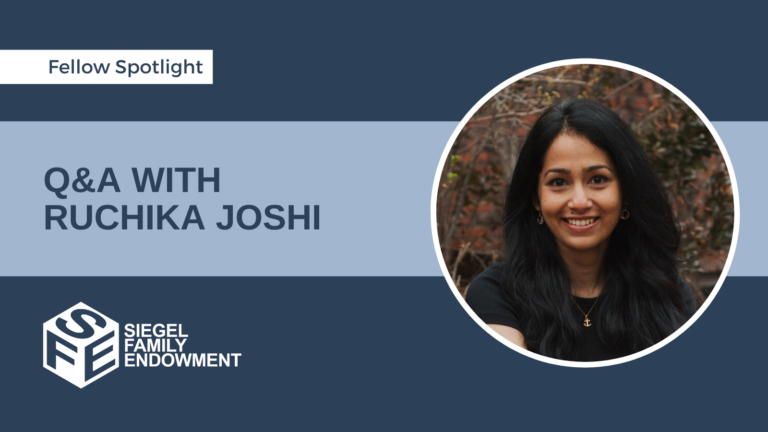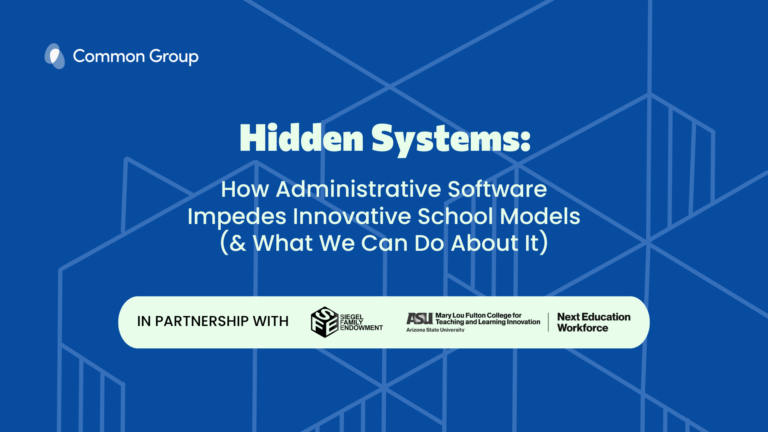Amber Oliver Reflects on the The Robin Hood Learning + Technology Fund’s Work and Approach
The Robin Hood Learning + Technology Fund is a well-known funder in the tech and education spaces, with a particular focus on blended literacy and computational thinking in New York City. The $50 million Fund takes a unique approach, investing in new models, using data-driven approaches, committing to external evaluation, working to secure follow-on funds, and supporting grantees who work and build within the communities they serve, especially within public schools and colleges in New York City.
Perhaps most unusually, the L + T Fund is a partnership between three philanthropic organizations: Overdeck Family Foundation, Robin Hood, and Siegel Family Endowment, a collaborative model that the Fund’s Managing Director Amber Oliver describes as its “superpower.”
In our conversation, Oliver discusses why work with external evaluators was “a gamechanger” for the Fund and its grantees; how the Fund helps initiatives pivot and scale; how AI can serve as a forcing function to accelerate movement toward student-centered models in education; and what’s next for the Robin Hood Learning + Technology Fund.
The Learning + Technology Fund is a collaboration between Robin Hood, Overdeck Family Foundation, and Siegel Family Endowment. What does that collaborative model offer that wouldn’t otherwise be possible?
Collaboration is really one of our unique superpowers. It took us some time to figure out how we were going to make the whole greater than the sum of our parts, but our model makes us so much stronger.
Education is a network of networks. Being in partnership with other foundations gives us connections to other organizations and contexts. Often in philanthropy, we’re in conversation with the same funders and the same programs in our narrow areas of focus. It’s really helpful when we can get out of that, when we get to be pushed into other adjacent contexts. It makes us smarter and better in ways that wouldn’t be possible without this collaboration. It becomes a co-ownership.
A good example of this is a recent luncheon that I attended at Regional Plan Association (RPA), a Siegel partner. The questions around transportation, housing, economic development, and other types of infrastructure have immediate implications for schooling and communities. The session accelerated my own learning in an efficient way that would not have been possible had Siegel not invited me into that room.
We’re also able to engage in national conversations in a way that we wouldn’t otherwise be able to as a place-based funder in New York City—even as a large one. Siegel and Overdeck are both national funders, and they’re able to help position us within the context of conversations to which place-based funders are sometimes not invited to bring their perspectives.
Robin Hood is known for its data-driven approach and for working to scale projects with track records of success. What does this focus on data, impact, and scalability look like in the context of the Learning + Tech Fund? How are you able to spur follow-on investments for grantees from other philanthropic funders?
We are known for taking risks on innovative and new ideas, but it’s really high risk, informed capital. We’re leveraging our expertise in the blended learning, high quality instructional materials, and computational thinking spaces, as well as our knowledge of the New York City educational ecosystem to make first-in dollar grants. Then we’re able to provide a pipeline for the kind of grantmaking that Siegel or Overdeck or Robin Hood or others might make. An organization taking the risk of trying something new knows that we are not a sustaining funder, but an entree to others.
We really take a learning orientation to our grants. They are often multi-year grants that have significant enough dollars so that the organization can actually implement and learn and come out with something that is concrete enough to build off—and ideally, fundraise against. But we also want grantees to be able to determine whether this is something that they want to continue to pursue, makes sense, and adds value.
To that end of taking a learning orientation, we pair grantees with an external evaluator at Columbia University’s Consortium for Policy Research in Education (CPRE) as an in-kind donation to the grantee. CPRE works with us to understand, in a structured way, whether our funding is having an impact. They have a partnership with the New York City Public Schools, so they’re able to capture student-level data and conduct rigorous research and evaluation in a way that is very difficult for any one nonprofit to do on its own.
In what ways is an external evaluator valuable? What does that process look like in practice?
Having that external evaluator has been a game changer for us. If it turns out that the program isn’t having the type of impact that was sought, CPRE uses the data to figure out if there is a pivot that would be possible within the multiyear grant. I’ll give an example from CUNY’s Computing Integrated Teacher Education (CITE) initiative. CUNY CITE is currently one of our most successful grants. It is designed to overhaul teacher preparation programs within the City University of New York (CUNY) system to better prepare teachers to integrate computational thinking and computing education into their instructional practice.
We initially gave CUNY CITE $2 million over two years to architect the program and figure out what it needed. We also paired them with CPRE. There were two pilots, and CPRE found that the first year of the program was less effective than hoped for both of them. The pilot at Hunter College had incredible rigor but was struggling to scale. The pilot at Queens College had incredible reach but wasn’t having the desired impact on practice.
With that information, we went to CUNY and asked whether they would be open to merging the scale of the Queens College program with the content of the Hunter College program. That would require changes to the leadership structure and greater collaboration. But the data was telling us that it could help us achieve our joint objectives for the program.
They agreed and we began to achieve scale and change practice. That was an example of informed risk and data-driven decision-making. It showed the Fund’s ability to establish trusting and open relationships with our partners. It was also an example of the importance of working with communities and schools. All of the programs that we fund are designed in collaboration with those they will serve; we aim to build for the real world, not in a petri dish.
The CUNY CITE program has been incredibly successful. Its ability to scale across the largest public institution in the country has made it a uniquely strong example of how first-in, informed and flexible funding can help to catalyze system-level change, and ultimately was able to unlock more than $12 million from entities like Gotham Gives, Google, and New York City Public Schools to reach thousands of teachers and almost 400 faculty members.
At the Learning + Technology Fund, you have your ear to the ground about emerging technologies. What changes do you think generative AI will force upon educational systems?
I think we all wish that education was functioning differently, that it was working for all students. I think that AI can be a forcing function to achieve the type of educational system that we want, that is based around student-centered models and that prioritizes critical thinking. AI can be an accelerant, to force real change.
For example, we have always wanted to be able to have a portfolio approach where students can demonstrate mastery of learning in multiple modalities. But very few teachers have the time to review hundreds of students’ writing, videos, simulations, or presentations. AI could be a co-pilot for teachers. It’s not about taking humans out of the loop. It’s about leveraging the AI to make us much more efficient and effective, and enable us to do these things that we weren’t able to do before.
I’m a tech optimist, but I’m also not naive. There are lots of things to be worried about. If we are not intentional about access and equity, AI could further exacerbate the inequities that currently plague our system. For decades, we have tried to increase access to computing education, and yet it is still largely reserved for wealthier communities and struggles with gender and racial imbalance. We need to make sure AI helps us close these divides, not widen them.
I also worry that nonprofits are not really able to lead at this moment. Most of the new AI innovation is coming from industry, which is not necessarily set up to champion underserved communities. Industry may also be less willing to disrupt the current educational paradigm because doing so might not be the fastest way to revenue and sales. Maybe you’re doing things better or faster, but not really differently in any meaningful way. That is not to say that all industry is bad and nonprofits are good. We need everyone at the table driving toward an AI future that increases opportunity.
How are the Learning + Tech Fund and its grantees working to mitigate those concerns about generative AI? What’s next for The Learning + Tech Fund?
We see the potential for using AI as an accelerant for personalized learning and computational thinking. For example, we gave grants to Teaching Lab and CommonLit to think about how to leverage AI as part of their blended literacy work. But these two partners are the exception, not the norm.
That’s why we’re working on building the capacity for nonprofits to lead on generative AI. This is the Decoded Futures collaboration we recently launched with Tech:NYC Foundation. Through that collaboration, we’re helping to build the infrastructure for all nonprofits to gain the AI capacity and skills needed to improve outcomes for families living in poverty in New York City. The grant will initially reach 115 education nonprofits and will be focused on both operational and programmatic uses of AI. What’s learned here will influence a larger, sustainable AI program that can be applied across the entire New York City social sector.
We are creating a standard and setting the pace for AI adoption and ensuring nonprofits are able to meaningfully engage and lead during this moment of transition and opportunity. Through that we also see the potential for increased efficiency, demand, and impact in computational thinking and blended learning. As an example, CUNY CITE is building that capacity at a systems-level.
Ultimately we see an opportunity to influence the entire system. We want to create sustainable scale beyond the lifetime of the Learning + Technology Fund, which sunsets in 2027. There is a lot to be concerned about. But there is also a lot to be excited about. I feel lucky to experience that excitement through interactions with Learning + Technology Fund partners and the educators, students and families they serve every day.
###
Amber Oliver is Managing Director of the Robin Hood Learning + Technology Fund, a collaboration between Robin Hood, Overdeck Family Foundation and Siegel Family Endowment to transform learning for low-income students with technology. Previously, Amber was the COO of GripTape, where she helped build a strategy to put 1M youth in the driver’s seat of their own learning. Amber also served as the VP of Globaloria, now Proto and part of Carnegie Learning, which helped thousands of students become knowledge-producers as they learned to design and code their own educational games. Amber has also held positions at UNICEF, the United Nations Secretariat, The World Bank, the Economist Intelligence Unit, and led efforts in Bangladesh, France, India, Niger and Senegal. She holds a Master’s degree in International Affairs from Columbia University and a Bachelor’s degree from Brown University.





